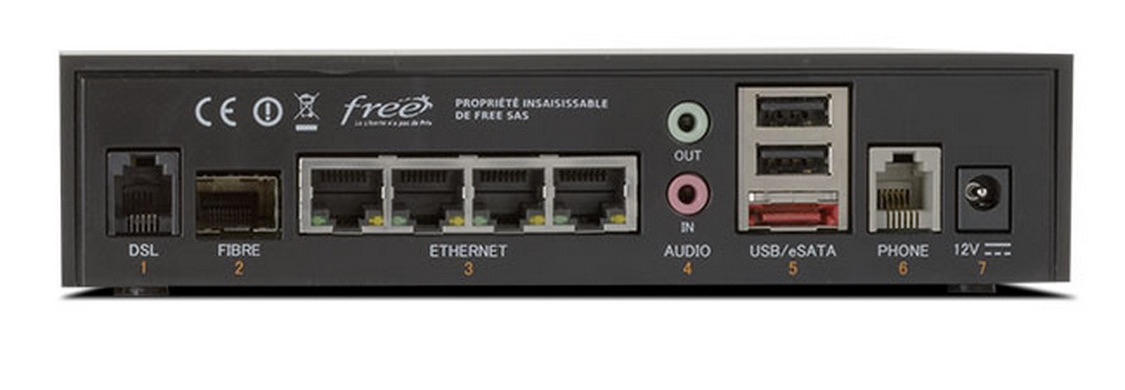Today I will discuss how to configure 6rd on the French ISP Free, if you decide not to use the provided Freebox and instead use your own equipment.
Free has been deploying to their customers since 2007. They were one of the first major ISPs to provide customers with IPv6 connectivity. But providing IPv6 for such a long time means they have not always kept up with the latest innovations, and thus Free don’t provide services like DHCPv6 or native IPv6 on some circuits.
If you have FTTH (100/1000MBit), your Freebox will be using the fibre SFP provided during installation. If you instead have xDSL, it will use the included cable to connect directly to the phone line using the DSL port.

With the Freebox, you will have IPv4 and IPv6 connectivity without any effort. But, if you wish to use your equipment after the Freebox you must put it into “bridge” mode and suffer dual NAT. You will also be limited by the features of the Freebox and have to trust Free to keep it updated and safe from vulnerabilities.
Those who choose to use their own equipment must have a device compatible with an SFP adapter, and configure VLAN 836 to receive an IPv4 address via DHCP.
Since IPv6 is provided using IPv6-in-IPv4, further configuration is necessary.
If you are using Mikrotik equipment, detailed documentation exists on how to configure 6rd.
If you are using a Linux-based router (e.g. OpenWrt) the process is slightly different, though the principles remain the same.
Free has an IPv6 prefix of 2a01:e00::/26, with the prefix 2a01:e3a being used for 6rd. The first step to getting working 6rd, is to determine which 6rd gateway Free is using for your IP address. The simplest way to determine this, is to calculate your IPv6 address.
Note: Don’t bother buying a copper SFP and using it in the Freebox to man-in-the-middle the fibre connection with a switch mirror port. It won’t fit physically, and even if you find a way, the Freebox won’t recognize it. ¯\_(ツ)_/¯
Use the prefix 2a01:e3a + your Free IPv4 address in hexadecimal. For example, if your IPv4 address is 8.8.8.8, the first IPv6 subnet would be 2a01:e3a0:8080:8080::/64
Confirm that your IPv6 address calculation is correct by using an online tool to ping the ::1 IP address in this IPv6 subnet, while running tcpdump on your router and filtering for protocol 41. If you have calculated the IPv6 address correctly, you should see IPv4 encapsulated IPv6 packets reaching your router:
# tcpdump -i eth0.836 proto 41
07:29:54.229910 IP 192.88.99.101 > lns-bzn-30-XX-XX-XX-XXX.adsl.proxad.net: IP6 2600:3c01::f03c:91ff:fe93:48f8 > 2a01:e3A:ABBB:CCC1::1: ICMP6, echo request, seq 1, length 64At this point, since we have not configured the 6rd tunnel, you should not expect to see any echo replies from the IPv6 address. Note the source IP address of the packet, this is the 6rd gateway from Free.
Before continuing, you need to add a firewall rule to allow protocol 41 through your firewall to the IP address of the Free 6rd gateway. From the above tcpdump output, the rules to add would be:
iptables -I zone_wan_input -i eth0 -p 41 -s 192.88.99.101 -j ACCEPT
iptables -I zone_wan_output -o eth0 -p 41 -d 192.88.99.101 -j ACCEPTOpenWrt does include support for 6rd in Luci, but I was never able to have this configuration bring up a working 6rd tunnel. Instead I configured the tunnel manually in /etc/rc.local:
ip tunnel add 6rd mode sit remote 192.88.99.101 local 170.187.188.204
ip link set 6rd up
ip addr add 2a01:0e3A:ABBB:CCC0::1/64 dev 6rd
ip addr add 2a01:0e3A:ABBB:CCC1::1/64 dev br-lan
ip route add ::/0 dev 6rdThis is almost enough to have IPv6 connectivity working fully. However, your IPv6 routing will be broken, as this interface is manually created and doesn’t belong to the LAN or WAN zones.
To resolve this, go to the OpenWrt web GUI and create a new interface with the Unmanaged protocol, covering the 6rd interface. Assign the new interface to the WAN zone, and restart the firewall. IPv6 routing should now be functional.
You should also configure the LAN interface to have the Router Advertisement-Service and DHCPv6 Service in server mode. This will ensure clients receive an IPv6 address in the IPv6 subnet assigned to the LAN.
I recommend rebooting your OpenWrt router to ensure that your configuration is correctly applied on boot.
You can check that IPv6 is correctly configured correctly by using an online tool such as test-ipv6. If everything has been configured correctly, your test results should be positive!